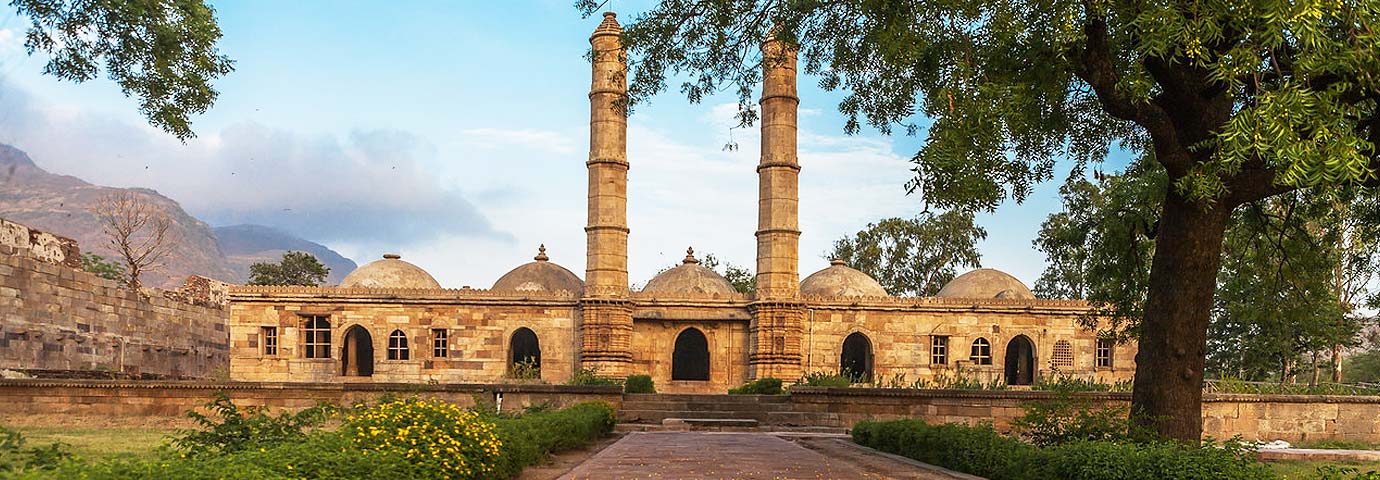The Champaner-Pavagadh Archaeological Park is an UNESCO World Heritage Site since 2004. Located in the Panchamahal district in Gujarat, the pre-Mughal city is a treasure of architecture, culture and history which is an interesting mix of Hindu and Muslim styles. It is the only site which has preserved Islamic designs before the era of Mughals. Cradled in an impressive landscape, the park preserves monuments which include pre-historic (chalcolithic) sites, a hill fortress and remains of the 16th century capital of the state of Gujarat. The Kalikamata Temple on top of Pavagadh Hill is considered to be an important shrine. Till date it attracts huge number of pilgrims throughout the year.
History
The Champaner-Pavagadh Archaeological Park has been witness to lots of events. It has observed centuries of rulers fighting over its possession and then abandonment. The city got its name from Vanaraj Chavda of Ahilwada (746 to 806 AD). It remained desolated till 400 AD. Rulers of the city were Allaudin Khilji, Chauhan Rajputs, Solanki Kings and Khichi Chauhans. A time of progress and peace came when it was re-built as a capital of an empire by Mehmud Begda. The region faced major devastation when looted by Mughal Emperor, Humayun in the early 16th century.
It was revived in 1803 when Britishers discovered the place. Baroda Heritage Trust tried to recover the grandeur but it ran short of funds. The declaration of the city and monuments as a UNESCO World Heritage Site prevented the total ruin of the region.
Monuments
The Champaner Pavagadh Archeological Park is full of monuments and buildings dating back to 8th to 14th century. The mystique of the region is the centuries of history accumulated in the walls. The Archeological Park monuments include fortified walls, mosques, tombs, Hindu and Jain temples, granaries, stepped wells and terraces. The Baroda Heritage Trust has identified 114 monuments in this archaeological park. But only 39 of them are maintained and looked after by Archeological Survey of India due to shortage of funds. Approximately 94 percent of land in the Champaner region is under forest department. The temples are maintained for devotees by the funds of the Association of Indian Temples.
The monuments worth exploring in Champaner include a Helical stepped well, Sakar Khan's Dargah, City Gate near Kasbin Talao, Citadel walls, City walls at south-east corner of the citadel going up the hill, East and South Bhadra Gates, Sahar ki Masjid (Bohrani), Mandvi or Custom House, Jami Masjid, Kevda Masjid and Cenotaph, Khajuri Masjid, Nagina Masjid, Lila Gumbaz ki Masjid, Kabutarkhana Pavilion, Kamani Masjid, Bawaman Mosque, etc.
In Pavagadh hill, the remnants of Atak Gate, Budhiya gate, Sadanshah-Gate, Sat Manzil, Gulan Bulan Gate, Buland Darwaza, Makai Kothar, Palace of Patai Rawal with tanks, Makai Gate, Tarapore Gate, The fort of Pavagadh, ruined Hindu and Jain temples, Navlakha Kothar deserves to be explored.
How to Reach
By Air: The nearest airport is the Vadodara Airport, about 42 km away from Champaner. The domestic airport is connected with many cities in India. From airport; taxis, buses and private vehicles take about one hour to reach the city of Champaner. The nearest international airport is in Ahmedabad, about 145 km away.
By Rail: Champaner has its own railhead. Vadodara is the main railway junction, located at a distance of 53 km. Buses and taxis are easily available from the main railway station to the historical city.
By Road: Champaner has good connectivity with major cities of Gujarat by extensive roadways. Buses, private vehicles, AC and non AC taxis commute frequently to the city.


